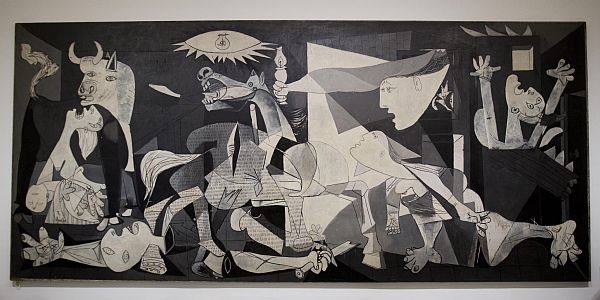 (Host) Scenes of Syrian civilians being bombed by their own government have reminded commentator and executive director of the Vermont Humanities Council Peter Gilbert of similar events that took place 75 years ago tomorrow – with far-reaching consequences for both civil society and the arts.
(Host) Scenes of Syrian civilians being bombed by their own government have reminded commentator and executive director of the Vermont Humanities Council Peter Gilbert of similar events that took place 75 years ago tomorrow – with far-reaching consequences for both civil society and the arts.
(Gilbert) On April 26, 1937, the Spanish Civil War was raging between the Spanish Republican government and the Nationalist forces of Generalissimo
Francisco Franco. Franco decided to try to demolish the government’s forces with one massive show of military might. And so, for four hours that afternoon, seventy-five years ago tomorrow, German and Italian planes, at the behest of Franco’s fascist forces, dropped explosive and incendiary bombs on the Basque city of Guernica, destroying the city. More than sixteen hundred people were killed. Europe hadn’t seen anything like it before. It wasn’t the first incidence of saturation bombing, but it was the first in Europe. We know the phenomenon now as “total war.”
In this terrible event, Pablo Picasso, the world’s most famous artist at the time, found the subject for one of the West’s greatest paintings. Gijs van Hensbergen’s history of the painting is entitled Guernica, the Biography of a Twentieth-Century Icon. It’s an appropriate title because the painting has come to symbolize the slaughter that characterized much of the century.
After the bombing, Picasso, a Spaniard living in Paris, worked at a feverish pace. In less than two months, he finished the enormous painting – 11 feet tall and 25 feet long. It’s an oil painting the size of a mural.
 It contains no explicit allusion to Guernica. Rather, it presents a disturbing jumble of terrible images of chaotic suffering and anguish: a horse howling in its death throes; the body of a dead warrior holding a broken sword; the head of a bull that’s been stabbed; faces – skull-like heads – with mouths open cry out, including a despairing mother holding her dead child in her arms; only the child’s mouth is closed in silence.
It contains no explicit allusion to Guernica. Rather, it presents a disturbing jumble of terrible images of chaotic suffering and anguish: a horse howling in its death throes; the body of a dead warrior holding a broken sword; the head of a bull that’s been stabbed; faces – skull-like heads – with mouths open cry out, including a despairing mother holding her dead child in her arms; only the child’s mouth is closed in silence.
Just a few weeks after it was finished, the painting was exhibited in the Spanish pavilion at the Paris International Exhibition at the 1937 World’s Fair, and then in numerous European cities. It toured the United States to raise money for the Spanish Refugee Relief Campaign. It spent the war years at the Museum of Modern Art in New York City, where it inspired American Abstract Expressionist painters. Van Hensbergen argues that the painting’s move to New York coincided with the center of gravity for Western art shifting from Europe to the U.S.
During the German occupation of Paris in World War II, the Gestapo visited Picasso’s apartment frequently, looking for evidence of wrong-doing. Once, when a German officer saw a photo of the painting on the table, he asked Picasso, “Did you do that?”
“No, you did,” Picasso replied.
Then Hensbergen points out that, although the painting is an icon of the carnage of twentieth-century warfare, after Franco’s death in 1975 it became a symbol of reconciliation in an increasingly democratic Spain. It now hangs in a museum in Madrid, the painting arguably more famous than the historical incident that inspired it.